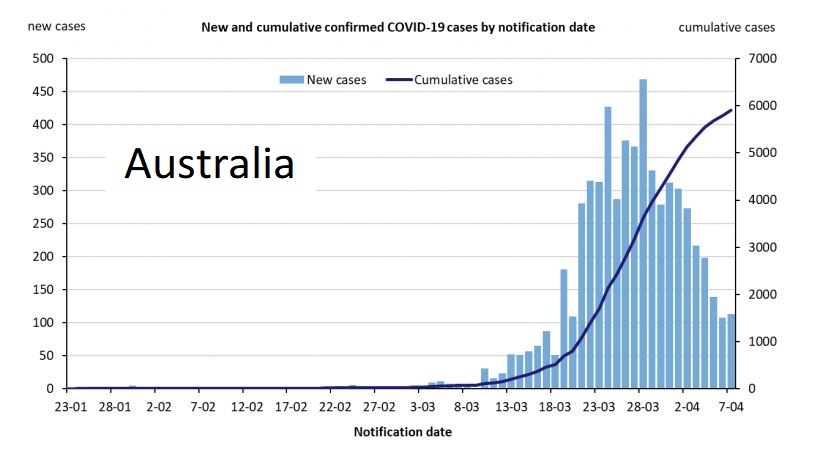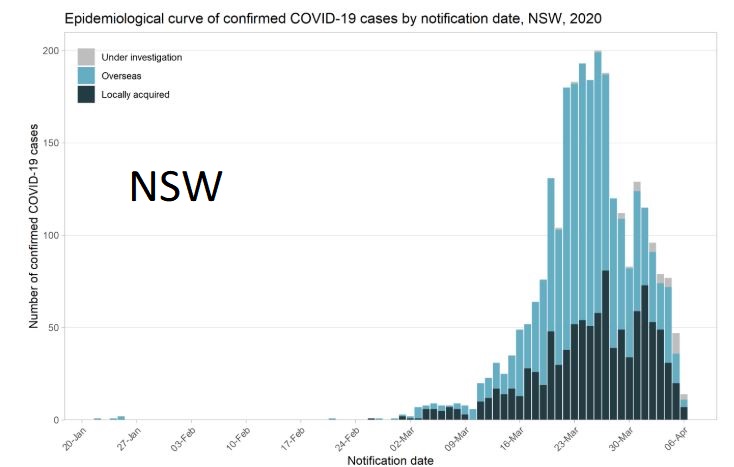There is so much anxiety and fear in the community, including amongst my patients, about COVID-19 (coronavirus).
It is impossible to turn on the radio, TV or social media without being confronted with negative COVID-19 information. My daughter refuses to watch the news on the TV because of this. Our minister in his sermon online for our church service last Sunday said: “I got in my car the other day I was feeling ok. I drove for 10 minutes and then got out feeling terrible. I heard so much bad news on the radio.” This sadly is so true. There is so much frightening negative information in both mainstream and social media that is resulting in so much fear and anxiety in the community.
These fears are compounded by the necessary social distancing and stay at home rules which result in social isolation. It is compounded by the consequential economic hardship in the community, with the closure or downsizing of so many businesses and companies and so many people losing their employment. I cannot recall Australia experiencing such adverse times in my lifetime.
A consequence of all these concerns is that the COVID-19 pandemic is detracting from women enjoying their pregnancies. This is so sad as being pregnant, having a baby is one of the most important and exciting times in a woman’s life. It should be a time of great joy and happiness not great fear and anxiety.
Personally, I find the news very depressing. I focus on the positive and let logic and facts dominate my thinking rather than having negative emotions. I encourage you to do the same.
The purpose of this article is to help my pregnant patients with some positive news.
1 The risk of being infected by COVID-19 is getting less
Australia, through excellent Federal Government measures, has one of the best COVID-19 report cards in the world. We have not only ‘flattened the curve’ but more importantly the number of reported cases of COVID-19 is getting fewer as time progresses.This is shown clearly in the graphs from both the Federal Government (for Australia) and the NSW Government (for NSW) below.


The graphs show there is considerably less risk of you being infected by COVID-19 today than in March.
Infected people arriving from overseas on planes and on cruise ships caused most of the steep increase in new case numbers in March. If we had no had people coming to Australia after October 2019 we would not have any COVID-19 infections in Australia. Now that people arriving from overseas on planes and on cruise ships are very few and those who do arrive are quaranteened for two weeks these high risk situations have been adequately addressed. Because of this and the Government’s containment policies, the incidence should remain low. Hopefully in a little while we won’t be seeing any new cases.
The continued decline in new cases will only continue if people are sensible and observe the social distancing, staying at home and hand washing rules containment rules. Sadly, there is a significant element in the community who arrogantly and blatantly ignoring these rules and in doing so not only put their own wellbeing at risk but also the wellbeing of other people in the community at risk.
While I commend the Government and hospitals for preparing for many new COVID-19 hospital admissions and many people with COVID-19 needing ICU admission and ventilators, assuming the current downward trend of new cases continues these COVID-19 hospital beds won’t be needed.
It is unlikely you will interact with a person with COVID-19
The NSW Government reports the detected incidence of detected COVID-19 infection for all of NSW is 32.21 per 100,000 residents (or 0.032%) (1). In other words, based on that statistic you will need to interact with 3,104 people before you interact with someone with a COVID-19 infection. This assumes this is the actual incidence of COVID-19 in the community. This is not the case. These 32.21 in 100,000 COVID-19 positive people have already been identified and are in self-quarantine or in hospital, so you won’t interact with these people. These 32.21 in 100,000 would be people who qualified for checking. It is unlikely that there will be the same incidence of people in the community who should have been tested because of symptoms, contacts or travel and who have not. While there will be some people in the community who are should be checked because of symptoms, travel or contacts and have not and there will be some people in the community in the incubation period and there will be some people in the community who have COVID-19 without symptoms or with atypical symptoms, I suspect this overall number will not be that great. I suspect the likelihood of you interacting with someone who is COVID-19 positive when you are in the community is less than 32.21 in 100,000 or 1 in 3,104 or or 0.032%.
You can minimise your risk:
- By following the suggestions in the article How to minimise your risk of getting coronavirus
- By only having ‘casual contacts’ with others as much as possible. The NSW Department of Health definition of casual contact is ‘face to face’ contact for less than 15 minutes or being in the same closed space with someone for less than 2 hours.
The incidence of diagnosed COVID-19 varies according to the suburb in NSW. The highest incidence for the most popular suburbs where my patients live is Blacktown which has an incidence of 0.029% (2)
You can check out the number of Covid 19 cases in your suburb at Find the facts about COVID-19.
Most people who die from COVID-19 are very senior in age and /or have significant comorbidities.
The mainstream media repeatedly shows coffins of people who have died from COVID-19. I suspect their goal is to frighten their viewing audience. But the media does not usually report statistical information about the people who have died. I suspect if they did it will detract from what I suspect is their goal.
The media does not tell you the median age of people who have died in Australia is 80 years (range: 60 to 94 years). The median age of all COVID-19 cases is 47 years (range: 0 to 100 years). That indicates the younger people who are infected are likely to recover.(3)
The media are keen to show you photos of young people and even children on ventilators, but they omit to tell you it is highly likely these young people and children will make full recovery and will not die.
I can’t locate reports on comorbidities (previous significant medical conditions) of those who have died in Australia, but it is likely they were present and very relevant, with consideration of their age. It is probable many died from their comorbidities rather than from COVID-19 infection.
In Italy the average age of those who’ve died from the virus is 79.5. More than 99% of their COVID-19 fatalities were people who suffered from comorbidities. All of Italy’s COVID-19 deaths under 40 have been males with serious existing medical conditions.(4)
In an excellent article What explains Covid-19’s lethality for the elderly? Scientists look to ‘twilight’ of the immune system it is reported Covid-19 kills an estimated 13.4% of patients 80 and older, compared to 1.25% of those in their 50s and 0.3% of those in their 40s.
Those percentage differences have to do with the body’s ability to mount an appropriate immune defence to the infection. But “It is not chronological age alone that determines how one does in the face of a life-threatening infection such as Covid-19,” cautioned geriatrician and gerontologist George Kuchel of the University of Connecticut. “Having multiple chronic diseases and frailty is in many ways as or more important than chronological age. An 80-year-old who is otherwise healthy and not frail might be more resilient in fighting off infection than a 60-year-old with many chronic conditions.” Reason: She may have a younger immune system.”
So, if a pregnant woman is infected, and even if the pregnancy dampens down her immune system response, statistics are she and her baby are likely to survive. Stay calm. Don’t be frightened.
I tell patients: “If you get COVID-19 infection it is very unlikely you or you baby will die, but it will result in huge management challenges for your pregnancy and childbirth. As well if you interact with someone of senior age or with significant comorbidities and if they are infected with COVID-19 consequently, they are at increased risk of dying.”
What is ahead?
The Government containment policies are working. But they will not be enough to take away the COVID-19 risk. A vaccine is needed. The Premier Gladys Berejiklian of NSW states COVID-19 social distancing to stay ‘until vaccine is found’. (5)
There are those in the community who are infected without any or with minimal symptoms or with non-respiratory symptoms. The symptoms of some people who are infected are gastrointestinal (such as anorexia, diarrhoea, vomiting and abdominal pain) (6). Others have loss of smell or taste (7).
Some people are blatantly ignoring the social distancing, stay at home and wash your hands Government policies. They may be spreading the virus because of their stupidity.
The incubation period varies. While the World Health Organization (WHO) currently estimates that the incubation period ranges from 1 to 14 days, with a median incubation period of 5 to 6 days is it also reported some people will be infectious for longer period. 101 out of every 10 000 cases will develop symptoms after 14 days of active monitoring or quarantine. (8)
The duration of a COVID-19 infection varies from person to person. If you are otherwise healthy, mild symptoms may go away after just a few days. If you have other health problems, such as a lung or heart condition, recovery may take weeks.
It is unlikely that normal overseas travel will resume soon. The Government will need to be confident that travel by air and sea will not result new COVID-19 cases being brought into Australia. When the COVID-19 infection came to Australia is was brought here by people who were infected overseas.
The virus may be spread in the community for some time. If the current containment rules are ended while there are people still infected, we can go back to where we started, with an increasing incidence of infection. Remember this global COVID-19 pandemic fire is thought to have started in a Wuhan, China ‘wet market’ as a small spark with only a few people infected. We need to be cautious as a community until we are confident will be no further infections.
- (1) https://preview.nsw.gov.au/covid-19/find-facts-about-covid-19
- (2) https://www.health.nsw.gov.au/Infectious/covid-19/Pages/stats-local.aspx https://www.google.com/search? and https://www.google.com/search?q=blacktown+population&oq=Blacktown+population&aqs=chrome.0.0l8.6799j0j8&sourceid=chrome&ie=UTF-8
- (3)https://www.health.gov.au/health-alerts/covid-19/case-numbers-and-statistics?language=en
- (4) https://www.bloomberg.com/news/articles/2020-03-18/99-of-those-who-died-from-virus-had-other-illness-italy-says
- (5) https://www.abc.net.au/news/2020-04-07/nsw-COVID-19-social-distancing-to-stay-until-vaccine-found/12126802
- (6) https://www1.racgp.org.au/newsgp/clinical/clinical-course-of-covid-19-what-gps-need-to-know
- (7) https://www.entuk.org/_userfiles/pages/files/loss_of_sense_of_smell_as_marker_of_covid.pdf
- (8) https://www.health.gov.au/sites/default/files/documents/2020/03/COVID-19-covid-19-information-for-clinicians.pdf https://www.acpjournals.org/doi/10.7326/m20-0504.
Also see


